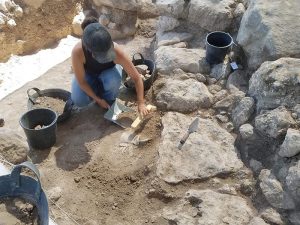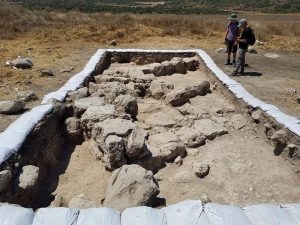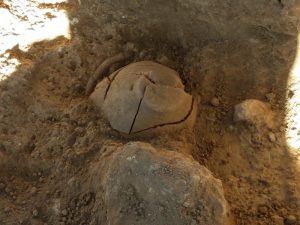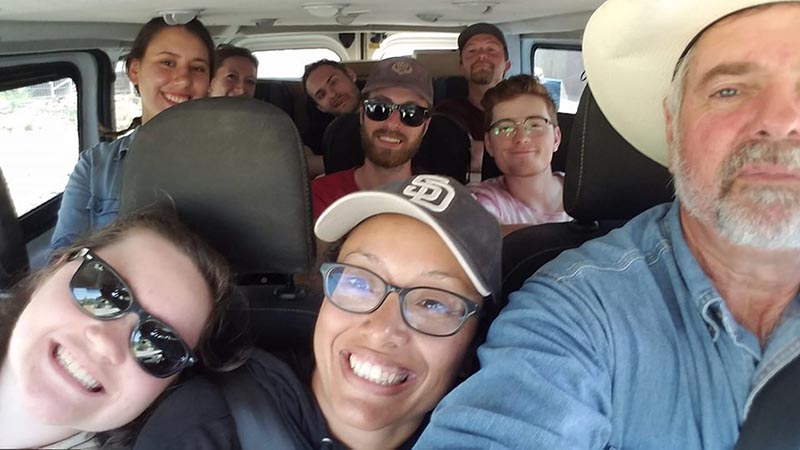
THE EDGE OF THE LATE BRONZE AGE CULT?
Marcella Barbosa, 2019 Eric and Carol Meyers Fellowship Recipient
Archaeologists have always been fascinated by the cult and made it the subject of study throughout their examination of human history. This examination is usually manifested through the study of things like temples, shrines, icons, and other enigmatic objects. The same is true for the Late Bronze Age in Canaan, especially when it comes to temples. Much work has been done on the subject; one only need to look at the information on individual sites, where excavators are always sure to highlight the temple, if there is one, or at other comprehensive works like Amihai Mazar’s chapter in The Architecture of Ancient Israel.

Me excavating by a Late Bronze wall in Area B3.
So far, when it comes to cultic architecture of the Late Bronze Age, most of the emphasis has been put on temples and shrines, which are, no doubt, fascinating. But the excavations in Area B1 at Tel Burna brought something different to the table.
Tel Burna is a site in the southern Shephelah that was occupied in the Bronze and Iron Ages. The site is dominated by the remains of an Iron Age Judahite fortress at the very top of the tel, but a shelf-like lower protrusion on the west side of the tel is what interests us when speaking about the Late Bronze Age. Here, on this lower shelf, is where the project opened Area B1 and discovered what the excavators interpret as a large open-air cultic enclosure, which was built on bedrock in many places. Its cultic nature is demonstrated by its assemblage of finds that include ceramic masks, seals, figurines, zoomorphic vessels, votive vessels, imports that included two large Cypriot pithoi, and several standing stones. Also, the analysis and distribution of bones and organic matter within the enclosure, along with the ceramic finds, seem to indicate that this was possibly a place for ritual feasting.

Area B3 at the end of the 2019 season.
The enclosure measured at least 25 meters by 25 meters, and obviously held a prominent place in Late Bronze Burna. The years of excavation uncovered much of this enclosure and its inner units, including the northern, western, and likely eastern outer walls. But much of the shelf that it sits on still remained unexcavated and the southern extent of the enclosure had yet to be found. For this reason, in the 2019 season, the project decided to open the new area B3 on this lower shelf just to the south of Area B1 with the goal of furthering our understanding of Late Bronze Age Burna and with the hopes of discovering the southern extent of the cultic enclosure. Due to my interest in Late Bronze Age Canaan and previous work at another Shephelah site, I was fortunate to supervise our new small area.
Due to the bedrock being so close to the surface, we can often see bits of possible architecture sticking out above the surface, and it was one of these areas that we chose to place the first square of Area B3, as it also intersected with where we thought the southern end of the LB cultic enclosure might be. We quickly came down on architecture, revealing two two-row walls, built with large stones, that were built into an integrated corner. The north-south wall also looks like it might have an extension built off the north end of the corner, though we cannot be certain of this without excavating the square to the north. Whatever the case might be, it was obvious that we had architecture with rooms the continued at least north, west, and south of this first square, and probably east as well. From this first square alone, we uncovered a large portion of a room/unit that produced an earthen floor and a good amount of restorable pottery. On the opposite side of this room/unit, to the south, was a small corner of another room/unit that also provided a relatively large amount of restorable pottery underneath tumbled stone.
As this room continued south into the baulk, and our shade cloth was already set up accordingly, we decided to open our second square to the south. We hoped that this would give us the rest of the room whose small corner we had excavated in the first square, as well as provide a clearer understanding overall for the complex, whether it be through continuation/alignment of walls and/or the finds uncovered within the units. We discovered that the south end of the north-south wall from the first square tapered off as it sat directly on a high point of bedrock. We also discovered two more walls, both single-row and built perpendicular to each other. This gave us the rest of the room whose corner we first discovered in the first square, though its boundaries to the south and southeast are somewhat ambiguous due to a high peak of bedrock. This room, though smaller than the other units uncovered in Area B3 so far even while being the only unit with its layout fully uncovered, provided a relatively large amount of restorable pottery, a few complete vessels, and a fragment of a plaque figurine. Its entrance lay to the west, and it appears there was quick access to the room to the north and another room to the south, though this intersection needs clarifying through excavation to the west.

Area B3 Foundation Deposit.
The room to the south, of which more than two by two meters was uncovered, was interesting in that no surface was found preserved and there was no obvious large amounts of restorable pottery, as there was in neighboring rooms. Yet, it did yield two lamp-and-bowl foundation deposits, which were collected carefully for possible organic material and possible residue analysis. The area to the south of the east-west wall revealed a layer of mudbrick collapse, where the shape of a few of the mudbricks were mostly preserved. Underneath this mudbrick layer, we uncovered the remains of at least two smashed storage jars in situ, with perhaps a third mixed in. Samples were taken from the storage jars for residue analysis and to search for remaining organic matter. These storage jars and mudbrick collapse lay on top of a hard-packed earthen surface, much like the one found in the first square. The nature of this particular unit is uncertain as we only have its northern wall, while the rest of it continued into the west, south, and east baulks. It might be part of a large room or an unroofed area or the outside of the complex; only further excavation will enlighten us.
What did strike the team is that while architecture was plentiful for the excavation of two squares, none of the walls seemed to absolutely line up with the cultic enclosure of Area B1 as we had expected, though we were only a few meters away from it. Also, the finds of Area B3 were not of the same ilk as those of Area B1, which helped identify that enclosure as cultic in nature. Thus, our preliminary interpretation is that the complex uncovered in Area B3 is not part of the cultic enclosure of Area B1, as we originally had thought it might be; rather, it appears that we reached and moved beyond the edge of the cultic enclosure to find a new, contemporary complex. Whether this new complex of Area B3 is residential or something else remains to be seen as we continue to excavate Area B3 and analyze the finds.

Read more about the Tel Burna Excavation Project.
Marcella Barbosa is a Ph.D. student of the Tandy Institute for Archaeology at Southwestern Baptist Theological Seminary in Fort Worth, Texas. She has been pursuing archaeology all of her life and has excavated in Menorca, Cyprus, and Israel, with the majority of her time so far spent in nine seasons with the Tel Gezer Project. She spent five years as the Collections Manager for the Tandy Archaeological Museum and is currently working on her dissertation/Gezer publication research in Israel thanks to a scholarship from Ariel University.
American Society of Overseas Research
The James F. Strange Center
209 Commerce Street
Alexandria, VA 22314
E-mail: info@asor.org
© 2025 ASOR
All rights reserved.
Images licensed under a Creative Commons Attribution-NonCommercial-ShareAlike 4.0 International License